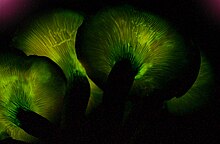Foxfire (bioluminescence)

Dark olive funnel ( Omphalotus olearius )

Bioluminescent fruiting bodies of the Herbern dwarf ball - appearance with bioluminescence in the dark compared to appearance with lighting with a flashlight
|
Foxfire ( English for "false fire", also known as shining wood ) describes a bioluminescence causedby certain fungi thatgrow on rotting wood.
distribution
Out of over 100,000 known mushroom species, only 71 are bioluminescent. Bioluminescence developed in four lines of descent. It could be proven that the bioluminescence phenomena in all four lineages are based on the same principles.
Generation and function of bioluminescence
The blue-green glow is attributed to luciferin , which is stimulated to emit light with the help of the enzyme luciferase by adding oxygen and peroxides , as is known from fireflies and marine glow animals . In 2009 Oliveira and Stevani were able to prove that it is a two-step enzymatic mechanism that differs from the bacterial mechanism. Unlike the bacterial mechanism in fungi could neither reduced riboflavin - phosphate ( FMNH 2 ) nor long-chain aliphatic aldehydes detected.
The purpose of bioluminescence in fungi is not clear, various theories have been put forward. One purpose could be to attract insects that react to bioluminescence so that they can eat the fungal fruit bodies and carry off the spores. Another purpose could be to deter light-sensitive, fungus-eating life forms. As a third possibility, apotropaic signals are assumed, the fungus lights up to indicate its toxicity.
history
The oldest known documentation of Foxfire comes from Aristotle from the year 382 BC. His remarks refer to a light which, unlike fire, is cold when touched. The Roman scholar Pliny the Elder also mentioned it as luminous wood that occurs in olive groves.
At the suggestion of Benjamin Franklin , it was used as a light in the Turtle , an early American submarine .
Although there is much more literature references for Foxfire by early scientists and naturalists, the real cause of this bioluminescence was unknown until 1823. Eventually the glow from wooden beams in underground mines was examined until it was found that it was fungus.
etymology
The word fox in the English term foxfire probably comes from the Old French word fols for 'wrong'. So it is not due to the English word fox for ' fox '.
In pop culture
- In the fifth season of the TV series Lassie , "Trapped" , Timmy and Boomer search for 'Foxfire' to keep girls away during a Halloween party.
- In the novel The Adventures of Huckleberry Finn by Mark Twain used Finn and Tom Sawyer, Foxfire 'as a light source to dig a tunnel.
See also
literature
- Konrad Dettner , Werner Peters : Textbook of Entomology, Part 1 . Springer DE, Heidelberg 2010 (2nd edition), ISBN 3-8274-2618-9 .
- Eberhard Breitmaier, Günther Jung: Organic chemistry: fundamentals, classes of compounds, reactions, concepts, molecular structure . Georg Thieme Verlag, Stuttgart, New York (US) 2012 (7th edition). ISBN 3-13-159987-1 .
- Osamu Shimomura: Bioluminescence: Chemical Principles and Methods . World Scientific, Singapore 2012, ISBN 9814366080 .
- Dennis E. Desjardina, Anderson G. Oliveira, Cassius V. Stevani, Fungi bioluminescence revisited , Photochem. Photobiol. Sci. 2008 , 7, 170-182. doi : 10.1039 / B713328F
Web links
- Bioluminescent mushrooms on Mykoweb.com (English)
Individual evidence
- ↑ Osamu Shimomura: Bioluminescence . Page 275-277.
- ↑ Anderson G. Oliveira, Dennis E. Desjardin, Brian A. Perry, Cassius V. Stevani, Evidence that a single bioluminescent system is shared by all known bioluminescent fungal lineages. In: Photochem. Photobiol. Sci. Volume 11, 2012, pp. 848-852. doi : 10.1039 / C2PP25032B .
- ↑ Eberhard Breitmaier, Günther Jung: Organic chemistry. Page 572.
- ↑ Anderson G. Oliveira, Cassius V. Stevani: The enzymatic nature of fungal bioluminescence, In: Photochem. Photobiol. Sci. Volume 8, 2009, pp. 1416-1421. doi : 10.1039 / B908982A .
- ↑ Konrad Dettner, Werner Peters: Textbook of Entomology . Page 600.
- ↑ Kim D. Coder: Foxfire: Bioluminescence in the Forest. (PDF; 17 kB) Warnell School of Forest Resources, archived from the original on May 7, 2013 ; accessed on July 18, 2011 (English).
- ^ Lincoln Diamant: Chaining the Hudson: The Fight for the River in the American Revolution . Fordham University Press, New York 2004, ISBN 978-0-8232-2339-8 , OCLC 491786080 .
- ↑ Firefox That Glows. Journey Idea, archived from the original on September 24, 2013 ; accessed on July 18, 2011 (English).
- ↑ Smythe Palmer, Abram: The Folk and Their Word-lore: An Essay on Popular Etymologies . 1904.
- ↑ Episode Guide: Season 5 (1958-1959) . Flying Dreams. Retrieved July 18, 2011.
- ↑ Mark Twain: 35: Dark, Deep-Laid Plans . In: Adventures of Huckleberry Finn . CreateSpace, 2011, ISBN 1-4635-2071-9 .

